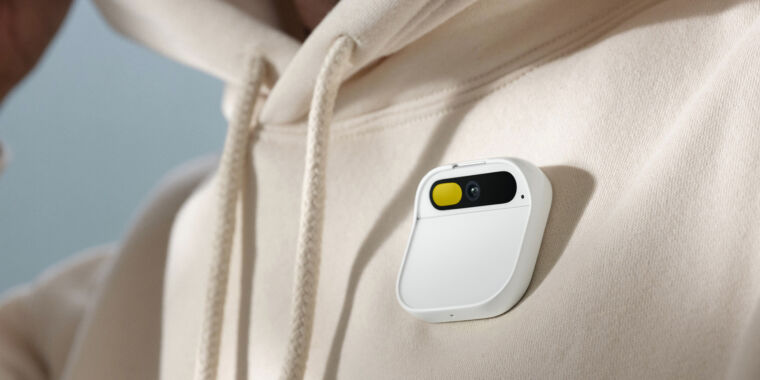A cutting-edge hardware company has recently generated significant buzz despite showcasing minimal features, reminiscent of the hype surrounding Magic Leap. The tech industry is abuzz with anticipation over the unveiling of a new device called the “Humane AI Pin,” touted as a potential replacement for smartphones. Priced at $700, this innovative gadget is a screenless voice assistant box that integrates AI technology, akin to the smartphones of the past decade. It seems like a fusion between a 1990s voicemail system and Google Glass.
Equipped with both a camera and speech capabilities, the Humane AI Pin operates as a voice assistant box, requiring users to press a button to interact with it since it lacks a wake word feature. The device necessitates users to wear it on their clothing at chest level using a magnetic attachment, leading to the peculiar act of pointing the camera at individuals during usage. Despite its “screenless” marketing, the device incorporates a sophisticated 720p laser projection system that projects a vivid color display, showcasing a user-friendly interface. The interface includes elements like a circular media player and scrolling text walls, allowing users to interact through simple hand gestures such as tapping fingers together.
However, the Humane AI Pin takes a step back by not supporting any third-party software, contradicting its ambition to replace smartphones. In a bold statement during the presentation, the company emphasized, “We don’t do apps,” distancing itself from the app-centric approach prevalent in the industry. The device’s functionalities and services integrated into the Android-based “Cosmos” OS are limited and locked to proprietary offerings, with a notable partnership with Tidal for music playback. The absence of a robust app ecosystem raises concerns about the device’s versatility and utility beyond its predefined capabilities.
Navigating the Humane AI Pin’s features can be challenging, especially without a dedicated touch interface, as users must rely on intricate gestures and interactions to control media playback and answer calls. The device’s complex user manual and unconventional input methods contribute to a steep learning curve, reminiscent of mastering a new language rather than a conventional user interface. Despite its technical specifications, featuring an eight-core Qualcomm processor, 32GB of storage, and 4GB of RAM, the device’s practical utility and processing capabilities remain ambiguous, particularly concerning its AI functionalities and voice control features.
The device’s standout feature is its advanced laser projection system, offering a unique visual experience akin to a sci-fi display. However, real-world usage scenarios may not align with the polished promotional materials, as environmental factors like hand positioning and lighting conditions can impact the display’s legibility. The device’s user interface, resembling that of a smartwatch, presents limited information in a simplistic layout, catering to the device’s compact form factor and usability constraints. Interacting with the UI through hand gestures adds a novel touch to the user experience, albeit with a learning curve associated with unconventional input methods.
Incorporating a 13 MP camera, the Humane AI Pin introduces privacy concerns akin to Google Glass, as users must navigate the social implications of constant camera usage. The device’s camera functionality enables hands-free recording and object recognition, allowing users to interact with the environment through voice commands and visual inputs. However, the practicality of certain features, such as object-based queries and nutrition tracking, may vary in real-world scenarios, raising questions about the device’s seamless integration into daily routines.
Despite its innovative design and ambitious features, the Humane AI Pin’s lack of an app ecosystem and reliance on proprietary services pose challenges to its widespread adoption and long-term viability. The device’s emphasis on voice commands and AI capabilities underscores its potential as a niche product catering to specific user preferences. As the industry awaits the device’s launch on November 16, the true test lies in users’ reception and acceptance of this unconventional approach to personal technology.






